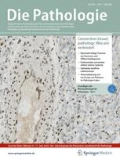Zusammenfassung
Bakterielle Infektionen der Knochen zählen zu den schwerwiegenden Erkrankungen mit Komplikationen bis hin zur dauerhaften Behinderung. Diagnostik und Therapie umfassen die Mikrobiologie, Histopathologie, Bildgebung, antibiotische und chirurgische Sanierung. Histopathologisch unterscheidbar sind die akute (Infiltration der Spongiosa durch neutrophile Granulozyten bis zur sequestrierenden Osteomyelitis), die spezifische (epitheloidzellige granulomatöse Entzündung; bei Tuberkulose, Lues oder Pilzinfektion), die primäre bzw. sekundäre chronische Osteomyelitis (lymphozytäres entzündliches Infiltrat) sowie Sonderformen (ohne einheitliche Histologie; Brodie-Abszess, SAPHO-Syndrom). Von großer Bedeutung ist der Malignitätsausschluss (Sarkome, Lymphome). Gewebliche Reaktionsmuster in der Nachbarschaft maligner Tumoren können histopathologisch Ähnlichkeiten mit einer Osteomyelitis aufweisen; bei unklarer Befundkonstellation muss an eine solche gedacht werden. Für eine sichere Diagnose ist deshalb die ausreichende Größe des Biopsats Voraussetzung. Klinische Informationen, Befunde der Mikrobiologie und bildgebenden Verfahren sowie die interdisziplinäre Zusammenarbeit von Orthopäden, Radiologen, Mikrobiologen und Pathologen sind notwendig.
Abstract
Bacterial infection of the bone is a severe disease with complications, potentially including long-term physical disability. The diagnosis and therapy of osteomyelitis include several elements: histopathology, microbiology, radiologic imagining, as well as antibiotic and surgical therapy. Histopathologists differentiate between acute osteomyelitis (infiltration of cancellous bone with neutrophile granulocytes); specific osteomyelitis (epithelioid-like granulomatous inflammation, tuberculosis, mycotic infections); primary/secondary chronic osteomyelitis (lymphocytic infiltration); and special forms of chronic osteomyelitis (varying histomorphology, Brodie abscess, SAPHO syndrome). Another important task in the histopathological diagnosis of inflammatory bone diseases is to differentiate osteomyelitis from malignant entities (sarcoma, lymphoma). Therefore, biopsy samples should be of sufficient size for safe diagnosis. Clinical information and imaging as well as interdisciplinary teamwork between radiologists, microbiologists, orthopedic surgeons and pathologists is mandatory to verify these diagnoses.






Literatur
Alonge TO, Wale A (1999) Intraoperative antibiotic bead maker-point of technique. Afr J Med Sci 28(3–4):193–194
Arias F, Mata-Essayag S, Landaeta ME et al (2004) Candida albicans osteomyelitis: case report and literature review. Int J Infect Dis 8(5):307–314
Baltensperger M, Grätz K, Bruder E et al (2004) Is primary chronic osteomyelitis a uniform disease? Proposal of a classification based on a retrospective analysis of patients treated in the past 30 years. J Craniomaxillofac Surg 32(1):43–50
Battmann A, Jürgens I (2004) Pathophysiologie in: Hendrich C, Frommelt L, Eulert J (Hrsg) Septische Knochen- und Gelenkchirurgie, Springer, Berlin Heidelberg, ISBN 3–540–21341–21344
Bühler M, Engelhardt M, Schmidt HGK (2003) Septische postoperative Komplikationen, Atlas für Unfallchirurgen und Orthopäden. Springer, Wien New York
Colina M, Lo Monaco A, Khodeir M, Trotta F (2007) Proprionibacterium acnes and SAPHO syndrome: a case report and literature review. Clin Exp Rheumatol 25(3):457–460
Diefenbeck M, Hofmann GO (2003) Behandlungsstrategie bei Frühinfekt nach operativer Frakturversorgung. Trauma Berufskrankh 5(Suppl 2):309–312
Flückinger U, Zimmerli W (2001) Osteomyelitis. Schweiz Med Forum 6:133–137
Flückiger U, Zimmerli W (2004) Diagnosestellung und Verlaufsmonitoring der postoperativen bakteriellen Osteitis. Orthopade 33:416–423
Frommelt L (2004) Leitlinien zur antimikrobiellen Therapie in Situationen periprothetischer Infektionen bei Hüft-Totalendoprothesen. Orthopade 33(7):822–828
Gardam M, Lim S (2005) Mycobacterial osteomyelitis and arthritis. Infect Dis Clin North Am 19(4):819–830
Gerard M (2000) Tuberculosis associated with the human immunodeficiency virus. Rev Med Brux 21(2):75–83
Girschick HJ, Huppertz HI, Harmsen D et al (1999) Chronic recurrent multifocal osteomyelitis in children: diagnostic value of histopathology and microbial testing. Hum Pathol 30(1):59–65
Gregosiewicz A, Okonski M, Stołecka D et al (1989) Ischemia of the femoral head in Perthes‘ disease: Is the cause intra- or extravascular. J Pediatr Orthop 9(2):160–162
Hansis M, Arens St, Wingenfeld C (1997) Infektionsraten in der Unfallchirurgie – eine Übersicht anhand der neueren deutschsprachigen Literatur. Unfallchirurg 100:457–464
Hendrich C, Frommelt L, Eulert J (Hrsg) (2004) Septische Knochen- und Gelenkchirurgie. Springer, Berlin Heidelberg New York, ISBN 3–54021341–21344
Hofmann GO (2004) Infektionen der Knochen und Gelenke. Urban & Fischer, München Jena, ISBN3–437–23400–5
Klemm K (1976) Die Behandlung chronischer Knocheninfektionen mit Gentamycin-PMMA-Ketten und-Kugeln. Unfallchir [Sonderheft Gentamycin-PMMA-Ketten/-Kugeln]
Kriegsmann J, Hopf T, Jacobs D et al (2009) Anwendungsmöglichkeiten der Molekularpathologie bei Gelenksinfektionen. Orthopade 38(6):531–538
Liener UC, Suger G, Kinzl L (2001): Knochen- und Gelenkinfekte. In: Wirth CJ (2001) Praxis der Orthopädie. Georg Thieme, Stuttgart New York, ISBN 3–13–125683–125684
Perry CR (1996) Bone and Joint Infections. Martin Dunitz, London
Schilling F (1998) Chronisch rekurrente multifokale osteomyelitis (CRMO). Rofo (168)2:115–127
Schmelz A, Kinzl L, Einsiedel T, Osteitis (2006) Infektionen des Bewegungsapparates. Chirurg 77:943–961; Quiz 962
Schmidt HGK et al (2010) Osteomyelitis Definitions Score. Z Orthop Trauma: im Review
Schnettler R, Steinau HU (2004) Septische Knochenchirurgie. Georg Thieme, Stuttgart New York, ISBN 3–13–116981–116988
Song XH, Ding LW, Wen H (2007) Hydatid bone disease. Postgrad Med J 83(982):536–542
Tekkök IH, Berker M, Ozcan CE, Akalin E (1993) Brucellosis of the spine. Neurosurgery 33(5):838–844
Tiemann AH, Hofmann GO (2009) Principles of the therapy of bone infections in adult extremities: Are there any new developments? Strategies Trauma Limb Reconstr 4(2):57–64
Tiemann AH, Diefenbeck M, Mückley T, Hofmann GO (2008) Hyperbare Sauerstofftherapie in der Osteitisbehandlung – Gibt es Neuigkeiten? Zentralbl Chir 133:396–398
Uehlinger E (1977) Abszedierende Typhus Osteomyelitis (Brodie Abszess) der Patella. Arch Orthop Unfallchir 88(2):255–257
Van der Ven A, Chapman CB, Bowker JH (2009) Charcot Neuroarthropathy of the foot and ankle. J Am Acad Orthop Surg 17(9):562–571
Waldvogel FA, Medoff G, Swartz MN (1970) Osteomyelitis: a review of clinical features, therapeutical considerations and unusual aspects. Three parts. N Engl J Med 282:198–206, 282:260–266, 282:316–322
Walzmann M, Wade AA, Drake SM, Thomas AM (1986) Rest pain and leg ulceration due to syphilitic osteomyelitis of the tibia. Br Med J (Clin Res Ed) 293(6560):804–805
Windolf J, Konold P (1997) Fallbericht einer primär chronischen Osteomyelitis. Unfallchirurgie 23(1):23–29
Wittekind Ch, Compton CC, Greene FL, Sobin LH (2002) Residual tumor classification revised. Cancer 94:2511–2519
Zimmerli W, Flückinger U (2004) Klassifikation und Mikrobiologie der Osteomyelitis. Orthopade 33(3):267–272
Interessenkonflikt
Der korrespondierende Autor gibt an, dass kein Interessenkonflikt besteht.
Author information
Authors and Affiliations
Corresponding author
Rights and permissions
About this article
Cite this article
Tiemann, A., Krenn, V., Krukemeyer, M. et al. Infektiöse Knochenerkrankungen. Pathologe 32, 200–209 (2011). https://doi.org/10.1007/s00292-011-1417-3
Published:
Issue Date:
DOI: https://doi.org/10.1007/s00292-011-1417-3
Schlüsselwörter
- Osteitis
- Osteomyelitis
- Differenzialdiagnose von malignen Tumoren
- Chirurgische Sanierung
- Histopathologische Kriterien

